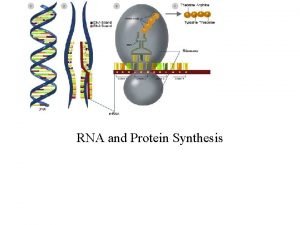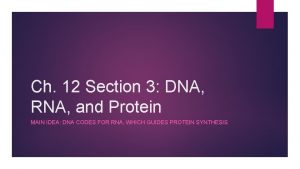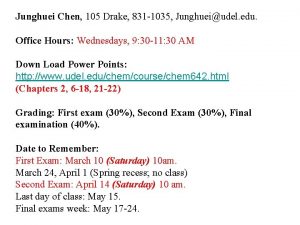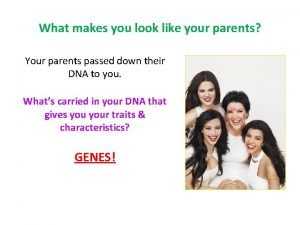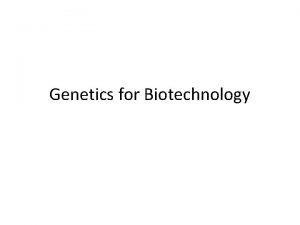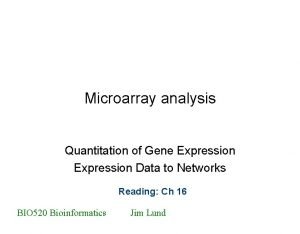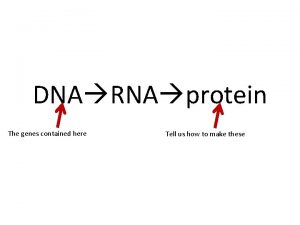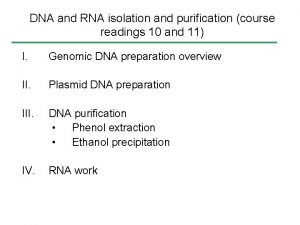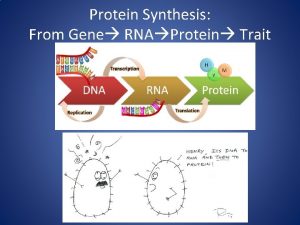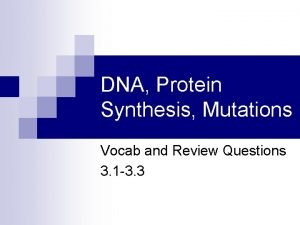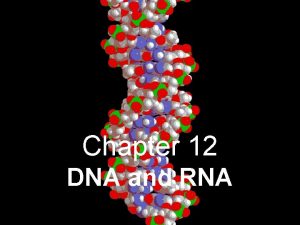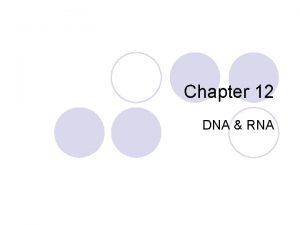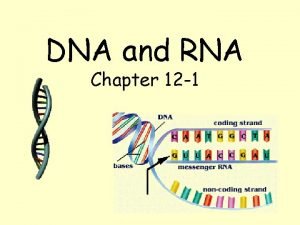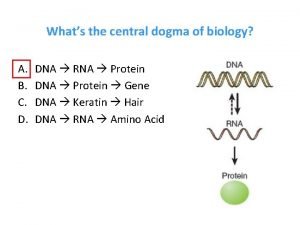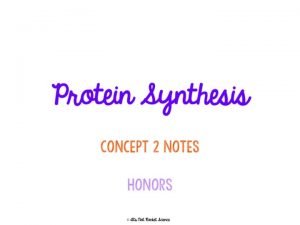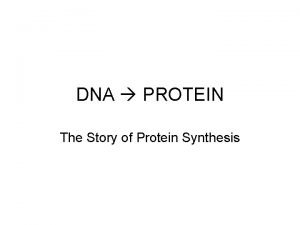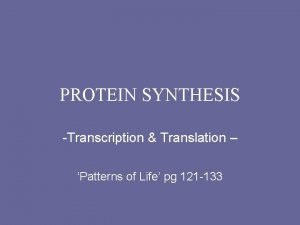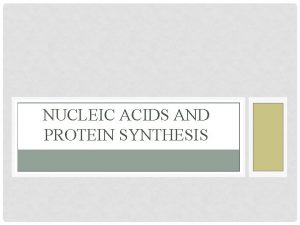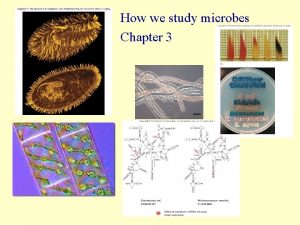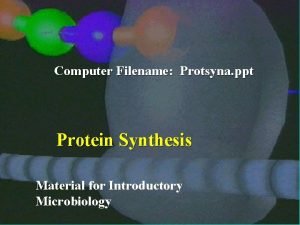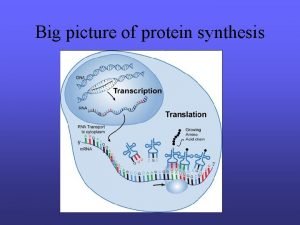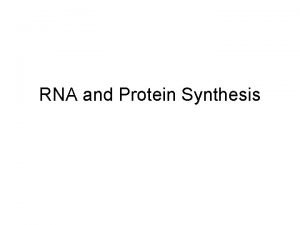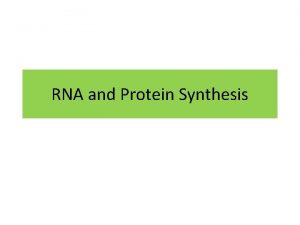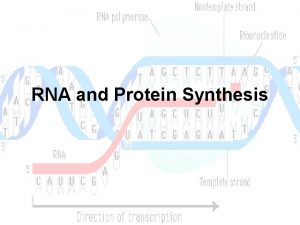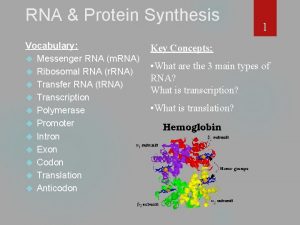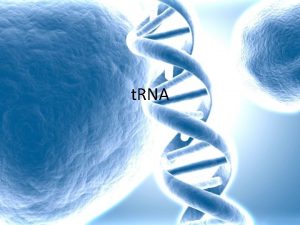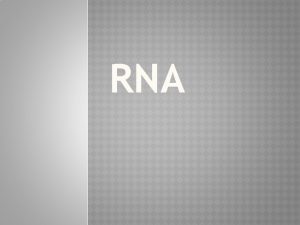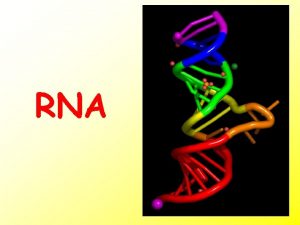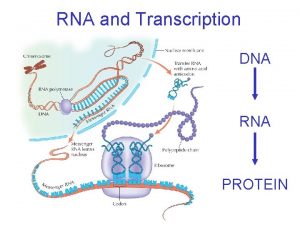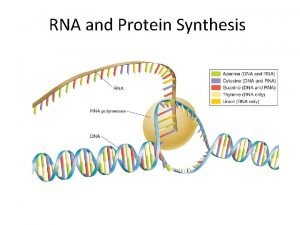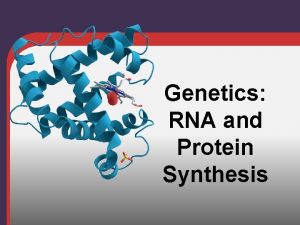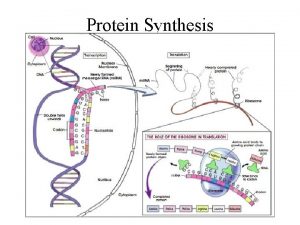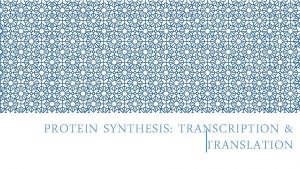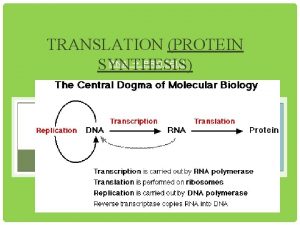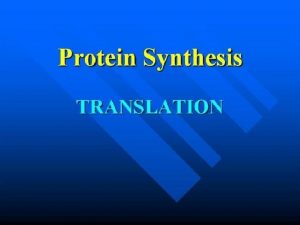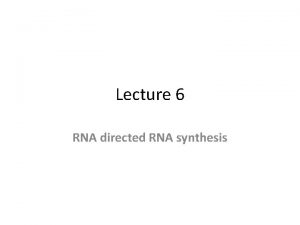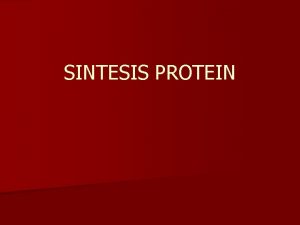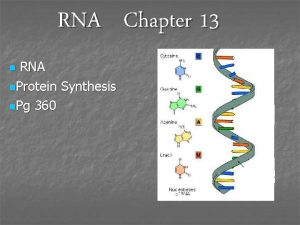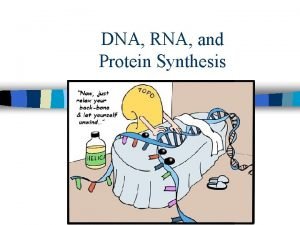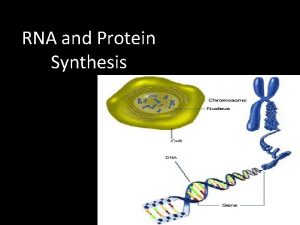CHAPTER RNA and Protein 13 Synthesis Protein Synthesis



































- Slides: 35

CHAPTER RNA and Protein 13 Synthesis Protein Synthesis 2: 30

The Human Code The human genome contains approximately 3 billion base pairs which reside in the 23 pairs of chromosomes within the nucleus of all our cells. Each of the estimated 30, 000 genes in the human genome makes an average of three proteins. Humans share 99. 9% of DNA with each other (We only differ by. 1% genetically!!!!) 98. 4% of DNA with Chimpanzees 50% of DNA with Bananas

Chapter 13 Questions: Part 1 In your notes answer the following questions as we go through the presentation. *Use complete sentences and write legibly 1. What is the role of RNA? Explain in relationship to DNA. 2. Explain the function of ribosomes. 3. Describe how m. RNA, r. RNA, and t. RNA work together to produce functional proteins.

Differences between DNA and RNA DNA Sugar = Deoxyribose Double stranded Bases RNA Sugar = Ribose Single Stranded Bases Cytosine Guanine Adenine URACIL (U) Thymine These chemical differences make it easy for the enzymes in the cell to tell DNA and RNA apart

What is RNA? Remember that DNA carries the genetic information in cells RNA - a single-stranded nucleic acid that contains ribose as its sugar RNA is involved in using DNA to code for Proteins The instructions from DNA are copied as RNA can be used to make proteins

The role of DNA and RNA in the cell The roles played by DNA and RNA are similar to the master plans and blueprints used by builders. DNA = The master plan: has all the information needed to construct a building. Builders never bring a valuable master plan to the building site!!!!! RNA = Blueprint: Inexpensive, disposable copies of the master plan called blueprints.

The 3 main types of RNA 1) Messenger RNA (m. RNA) Carries a copy of the instructions from the nucleus to the cytoplasm where it meets up with a ribosome to make a protein. 2) Ribosomal RNA (r. RNA) Makes up the structure of ribosomes 3) Transfer RNA (t. RNA) Transfers amino acids to the ribosomes to match them with the coded m. RNA message.

A 4 th type of RNA (not in you book) Small nuclear RNA (sn. RNA) Edits the m. RNA before it leaves the nucleus

How is RNA made? Transcription = DNA segments serve as templates to produce complementary RNA molecules (m. RNA) In eukaryotes transcription takes place in the nucleus m. RNA is the disposable copy of the DNA instructions Many m. RNA molecules can be made from one gene

The role of RNA polymerase = an enzyme that binds to DNA 1) Separates the DNA strand 2) Uses one DNA strand as a template to create an RNA molecule Promoter = region of DNA with specific base sequences that signal the RNA polymerase where to start making RNA m. RNA is edited before it leaves the nucleus Introns = regions that are cut out Exons = regions that form the final RNA

Chapter 13 Questions: Part 1 Answers 1. What is the role of RNA? Explain in relationship to DNA. The role of RNA is to transmit coded information found in DNA and create proteins. RNA is created from base pair sequencing found in DNA whereby all nitrogenous bases are paired up and Uracil replaces Thymine. 2. Explain the function of ribosomes. Ribosomes are responsible for creating polypeptide chains of amino acids which will result in the creation of new proteins. 3. Describe how m. RNA, r. RNA, and t. RNA work together to produce functional proteins. Messanger RNA (m. RNA) carries a coded message from DNA to the ribosome which is synthesized from ribosomal RNA (r. RNA). From this point transfer RNA (t. RNA) uses base pairing rules to bring amino acids to the ribosome for protein synthesis.

Chapter 13 Questions: Part 2 In your notes answer the following questions: 4. What are codons and what do they code for? 5. Define translation. 6. Explain the role of t. RNA and “stop” codons to produce polypeptide chains, which ultimately form new proteins.

The Genetic Code The bases in DNA and RNA - A, C, G, T (U) code for making proteins The 4 bases code for 20 different amino acids (proteins) The genetic code is read three “letters” at a time, so that each “word” is three bases long and corresponds to a single amino acid These amino acids can be combined into long chains = polypeptides � The sequence of amino acids determines the structure of the protein

Codon � Codon = each three-letter “word” in m. RNA consists of three consecutive bases that specify a single amino acid to be added to the polypeptide chain

The Genetic Code � There are 64 possible threebase codons (4 × 4 = 64) in the genetic code. � To read a codon, start at the middle of the circle and move outward. � GAG = Glutamic Acid � CGU = Arginine Start codon = AUG = methionine Stop codon = UGA, UAG

Translation = the decoding of an m. RNA message into a protein. Ribosomes use the sequence of codons in m. RNA to assemble amino acids into polypeptide chains

t. RNA � Each t. RNA molecule carries just one kind of amino acid. � Anticodon = three unpaired bases—which is complementary to one m. RNA codon.

The process of translation 1) A ribosome attaches to a m. RNA molecule in the cytoplasm. 2) As the ribosome reads each codon of m. RNA, it directs t. RNA to bring the specified amino acid into the ribosome. 3) One at a time, the ribosome then attaches each amino acid to the growing chain and breaks the bond between the t. RNA and amino acid

Translation 4) The t. RNA moves into a third binding site, from which it exits the ribosome. 5) The ribosome moves to the third codon, where t. RNA brings it the amino acid specified by the third codon.

Translation 6) The polypeptide chain continues to grow until the ribosome reaches a “stop” codon on the m. RNA molecule. 7) When the ribosome reaches a stop codon, it releases both the newly formed polypeptide and the m. RNA molecule, completing the process of translation.

Chapter 13 Questions: Part 2 Answers 4. What are codons and what do they code for? A codon consists of three consecutive bases that specify a single amino acid to be added to the polypeptide chain and ultimately produce a protein. 5. Define translation. Translation is the decoding of an m. RNA message into a protein. 6. Explain the role of t. RNA and “stop” codons to produce polypeptide chains, which ultimately form new proteins. t. RNA is responsible for transporting amino acids to the ribosome for protein synthesis. A “stop” codon signals that a polypeptide chain is complete.

protein folding transcription and translation

Central Dogma Information is transferred from DNA to RNA to PROTEIN � Exceptions include retroviruses (ex HIV) where information is moved from RNA to DNA Gene expression - the way in which DNA, RNA, and proteins are involved in putting genetic information into action in living cells.


The Genetic Code The genetic code is nearuniversal Some organisms show slight variations in the amino acids assigned to particular codons But the code is always read three bases at a time and in the same direction.

Mutations = heritable changes in genetic information Two categories of mutations 1) Gene mutations = mutations that produce changes in a single gene 2) Chromosomal mutations = mutations that produce changes in whole chromosomes

Gene Mutations Point mutations = mutations that involve changes in one or a few nucleotides Occur at a single point in the DNA sequence Usually occur during replication. If a gene in one cell is altered, the alteration can be passed on to every cell that develops from the original one.

Types of Gene Mutations Substitution - one base is changed to a different base � May change one amino acid Insertion – one base is inserted Deletion – one base is deleted � Insertion and deletions are frameshift mutations – they shift the reading frame of the message and change multiple amino acids

Sickle Cell Mutations The sickle cell mutation is a point mutation that affects the hemoglobin in red blood cells. A single base change from and adenine to uracil changes glutamic acid to valine

Sickle Cell Mutations This mutation however seems to “help” populations where malaria is endemic. (e. g. certain parts of Africa)…. . Why? Malaria affects 400 million people annually and kills 2 -3 million People with the sickle cell trait are more likely to survive acute malaria illness

Sickle Cell Mutations Red cells affected with malaria become deformed. People with the sickle cell trait remove those cells more affectively which reduce the parasite burden in people

Chromosomal Mutations Deletion – involves the loss of part of a chromosome Duplication – involves an extra copy of part or all of the chromosome Inversion – reverses the direction of part of the chromosome Translocation – when part of one chromosome breaks off and attaches to another

Chapter 13 Questions: Part 3 On a separate (clean – no rough edges) piece of paper answer the following questions: *Use complete sentences and write legibly Turn in Chapter 13 Questions from this presentation when you are finished. 7. Use a dictionary and define Dogma. 8. Explain the central dogma of gene expression as it relates to DNA, RNA, and Protein. 9. Define gene expression, and explain why the Genetic Code can be described as “near-universal”.

Chapter 13 Questions: Part 3 Answers 7. Use a dictionary and define Dogma. A principle or set of principles laid down by an authority as incontrovertibly true. 8. Explain the central dogma of gene expression as it relates to DNA, RNA, and Protein. In all living systems information is transferred from DNA to RNA to PROTEIN. 9. Define gene expression, and explain why the Genetic Code can be described as “near-universal”. Gene expression is the way in which DNA, RNA, and proteins are involved in putting genetic information into action in living cells. It can be considered “near universal” because it applies to nearly all living things.

Chapter 13 Extra Credit On a separate (clean – no rough edges) piece of paper answer the following questions: *Use complete sentences and write legibly Worth the read! And a good opportunity for 15 extra credit points! Go to http: //www. naturalhistorymag. com/samplings/033426/portrait-of-a-protein Read this short article and summarize how the researchers are able to look at proteins and how these images will benefit medical science. Due Monday for credit
 Section 12 3 rna and protein synthesis
Section 12 3 rna and protein synthesis Dna rna and protein synthesis study guide
Dna rna and protein synthesis study guide Section 12 3 rna and protein synthesis
Section 12 3 rna and protein synthesis Rna protein synthesis
Rna protein synthesis Rna protein synthesis
Rna protein synthesis Chapter 11 dna and genes
Chapter 11 dna and genes Chapter 12 section 3 dna rna and protein
Chapter 12 section 3 dna rna and protein Synthesis of rna
Synthesis of rna Dna rna protein central dogma
Dna rna protein central dogma Central dogma
Central dogma Microarray analysis
Microarray analysis Dna rna protein
Dna rna protein Dna rna protein diagram
Dna rna protein diagram Dna rna protein trait
Dna rna protein trait 4 steps of protein synthesis
4 steps of protein synthesis Protein synthesis and mutations
Protein synthesis and mutations Protein synthesis and mutations
Protein synthesis and mutations Chapter 12 dna and rna
Chapter 12 dna and rna Section 12-1 dna
Section 12-1 dna Chapter 12 dna and rna section 12-1
Chapter 12 dna and rna section 12-1 Cell restaurant analogy
Cell restaurant analogy Translation
Translation Bbc bitesize protein synthesis
Bbc bitesize protein synthesis Protein synthesis cookie analogy
Protein synthesis cookie analogy Protein synthesis
Protein synthesis Dna and rna
Dna and rna Protein synthesis
Protein synthesis Protein synthesis
Protein synthesis Synthesis
Synthesis Protein synthesis animation mcgraw hill
Protein synthesis animation mcgraw hill Molecular genetics and biotechnology
Molecular genetics and biotechnology Translation biology
Translation biology Ribonucleic acid
Ribonucleic acid Protein synthesis
Protein synthesis Protein synthesis ppt
Protein synthesis ppt Picture transcription
Picture transcription


